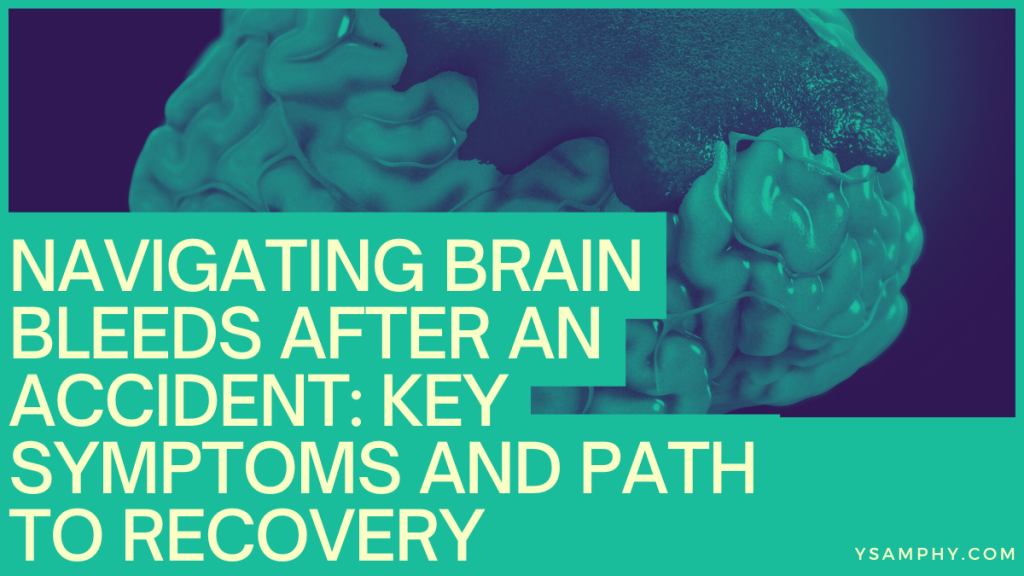Accidents can be jarring, and their consequences can sometimes be more severe than initially apparent. One such critical injury is a brain bleed. Consulting an MPLS brain injury lawyer may provide essential guidance if you find yourself in this situation. Understanding the symptoms and recovery process of a brain bleed can be vital for your health and legal rights if you or a loved one has been in an accident.

What is a Brain Bleed?
A brain bleed, also known as a hemorrhage, occurs when an artery in the brain bursts, leading to localized bleeding in the surrounding tissues. This bleeding kills brain cells and can cause swelling, known as cerebral edema. Brain bleeds can be classified into two main types:
- Intracerebral Hemorrhage: Bleeding within the brain tissue itself.
- Subarachnoid Hemorrhage: Bleeding between the brain and the tissues covering it.
Both types are serious and require immediate medical attention.
Causes of Brain Bleeds
Several factors can lead to brain bleeds, including:
- Head Trauma: A car accident, fall, or any blunt force trauma can cause vessels within the brain to burst.
- High Blood Pressure: Chronic hypertension can weaken blood vessel walls, making them more prone to rupturing.
- Aneurysms: Weak spots in blood vessel walls can expand and burst, leading to bleeding.
- Blood Vessel Abnormalities: Conditions like arteriovenous malformations (AVMs) make vessels susceptible to bleeding.
- Blood Disorders: Hemophilia and sickle cell anemia can contribute to spontaneous brain bleeds.
- Liver Disease: Can increase bleeding risk by disrupting blood clotting processes.
Recognizing the Symptoms
The symptoms of a brain bleed can vary widely depending on the severity and location of the bleeding. Early recognition can be crucial for treatment and recovery. Common symptoms include:
- Severe Headache: Often described as the worst headache of one’s life.
- Nausea and Vomiting: A sign of increased pressure in the brain.
- Blurred Vision: This manifests as poor vision or other visual impairments.
- Weakness or Numbness: Particularly on one side of the body.
- Difficulty Speaking: This may manifest as slurred or incoherent speech, making it hard to understand.
- Coordination Problems: Loss of balance or difficulty walking.
- Seizures: Sudden, uncontrolled electrical disturbances in the brain.
- Loss of Consciousness: In severe cases, a person may faint or slip into a coma.
If you notice these symptoms following an accident, immediately seek medical attention.
Diagnosing a Brain Bleed
Once at the hospital, healthcare providers will conduct several tests to diagnose a brain bleed. These may include:
- CT Scan: The most common imaging test to quickly identify bleeding.
- MRI: Provides more detailed images of the brain.
- Cerebral Angiography: An X-ray of the brain’s blood vessels.
- Lumbar Puncture: Analysis of cerebrospinal fluid for signs of bleeding.
Early and accurate diagnosis is crucial for effective treatment.
Treatment Options
Treatment aims to stop the bleeding, relieve pressure on the brain, and prevent complications. Treatment options vary based on the severity and location of the bleed but may include:
Medications:
- Antihypertensives: To control blood pressure.
- Anticonvulsants: To prevent seizures.
- Diuretics: To reduce swelling.
Surgery:
- Craniotomy: Removing part of the skull to relieve pressure.
- Endovascular Embolization: Minimally invasive procedure to block the blood vessel causing the bleeding.
Rehabilitation:
- Physical Therapy: To regain strength and coordination.
- Speech Therapy: To improve communication skills.
- Occupational Therapy: To help return to daily activities.
Road to Recovery
Recovery from a brain bleed is a gradual process and varies greatly among individuals. Factors influencing recovery include the bleed’s location, the extent of damage, and the patient’s overall health. Here are some general steps in the recovery process:
- Acute Care: Immediate medical intervention to stabilize the patient.
- Rehabilitation: Intensive therapy to regain lost functions.
- Ongoing Medical Care: Regular check-ups to monitor recovery progress.
- Support Systems: Emotional and psychological support from family, friends, and support groups.
Legal Considerations
If a brain bleed results from an accident, it’s essential to understand your legal rights. Meeting with a personal injury attorney, such as an MPLS brain injury lawyer, can help determine if you’re entitled to compensation for medical bills, rehabilitation costs, lost wages, and pain and suffering. They can provide guidance tailored to your situation. Documenting your symptoms, treatments, and interactions with healthcare providers can strengthen your case.

Conclusion
A brain bleed after an accident is a medical emergency that requires prompt attention. Recognizing the symptoms, seeking immediate medical care, and understanding your legal rights can significantly impact your recovery and well-being. If you have questions or need legal advice, don’t hesitate to contact our law firm to ensure you receive the support and compensation you deserve.

